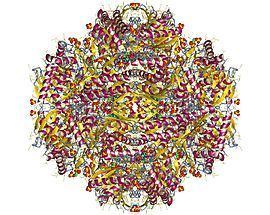EC number 1.2.1.24 ExPASy NiceZyme view Gene ontology 0004777 | CAS number 9028-95-9 | |
 | ||
In enzymology, a succinate-semialdehyde dehydrogenase (SSADH) (EC 1.2.1.24) is an enzyme that catalyzes the chemical reaction
The 3 substrates of this enzyme are succinate semialdehyde, NAD+, and H2O, whereas its 3 products are succinate, NADH, and H+.
This enzyme belongs to the family of oxidoreductases, specifically those acting on the aldehyde or oxo group of donor with NAD+ or NADP+ as acceptor. The systematic name of this enzyme class is succinate-semialdehyde:NAD+ oxidoreductase. Other names in common use include succinate semialdehyde dehydrogenase, succinic semialdehyde dehydrogenase, succinyl semialdehyde dehydrogenase, and succinate semialdehyde:NAD+ oxidoreductase. This enzyme participates in glutamate and butyrate metabolism.
Succinate-semialdehyde dehydrogenase is found in organisms ranging across the tree of life from bacteria to humans. It is important in the degradation of γ-aminobutyric acid in humans, and deficiency of the enzyme causes serious health effects (succinic semialdehyde dehydrogenase deficiency).
In bacteria, the enzyme is also involved in γ-aminobutyric acid degradation, but can be recruited to facilitate other functions, such as converting succinate-semialdehyde formed during fission of the pyridine ring to succinic acid for entry into the Krebs Cycle.
